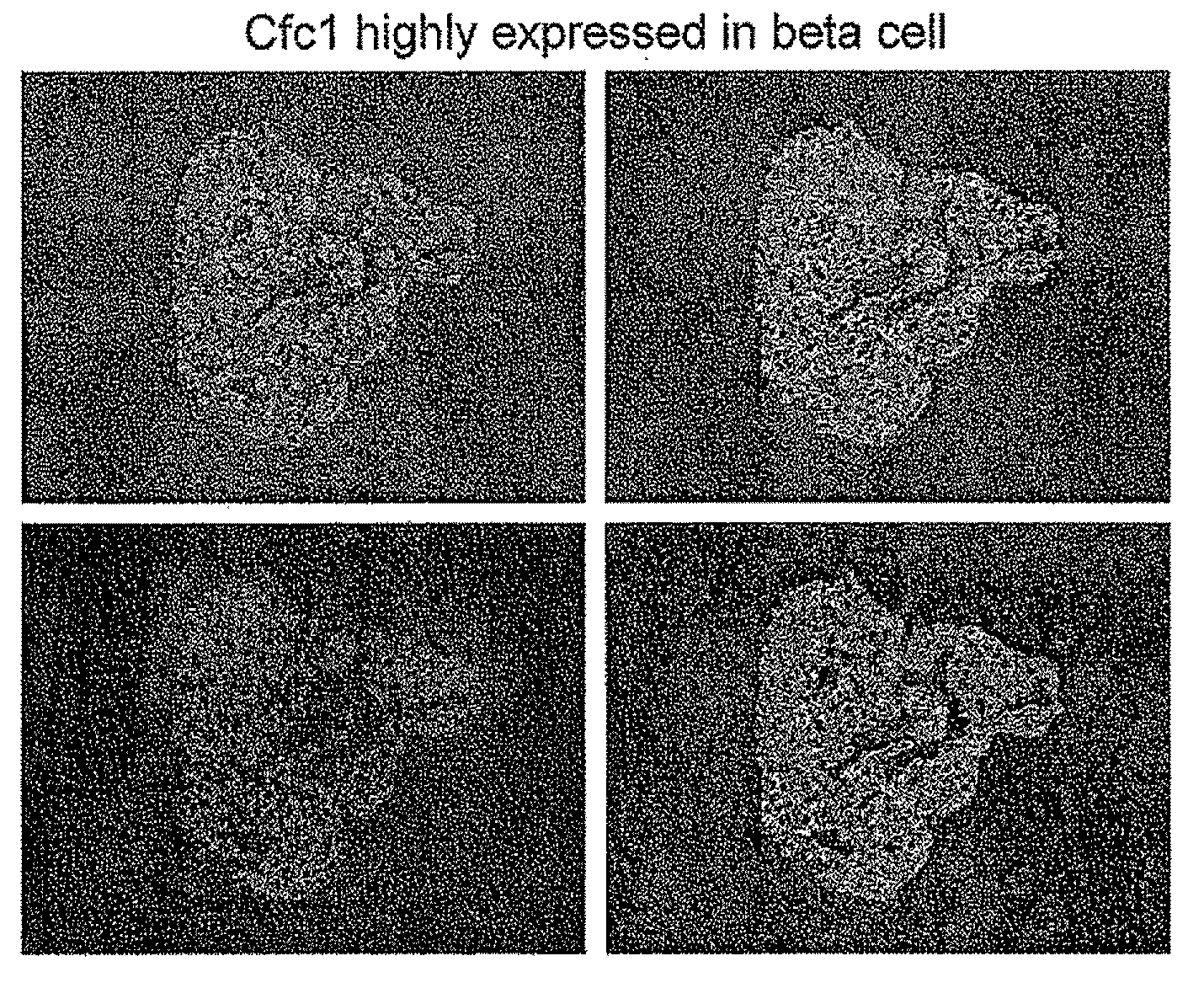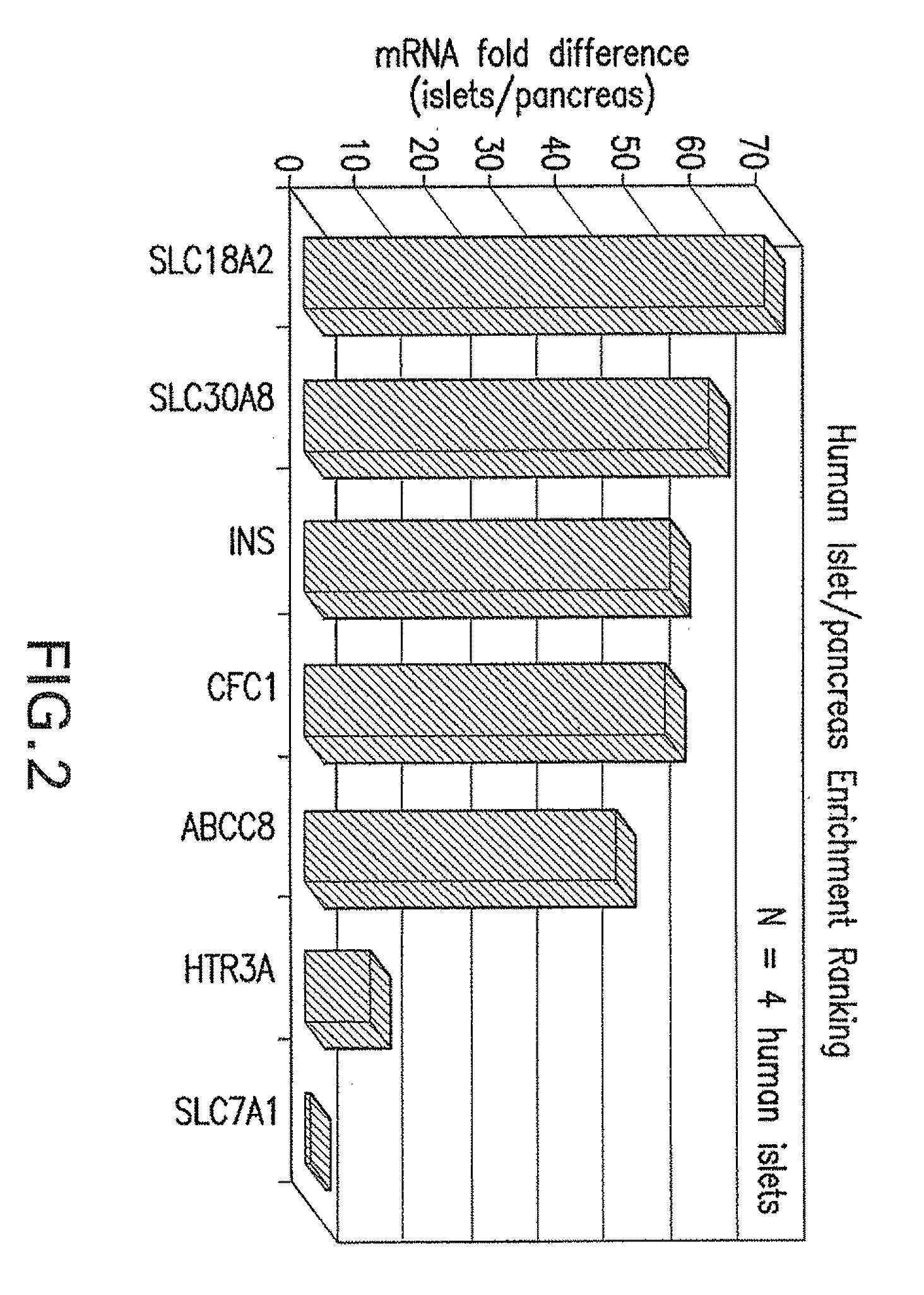Pancreatic beta-cell mass biomarker
- Summary
- Abstract
- Description
- Claims
- Application Information
AI Technical Summary
Benefits of technology
Problems solved by technology
Method used
Image
Examples
example 1
[0062]This Example shows that CFC1 is specifically enriched in human islets.
[0063]The custom ink-jet microarrays used for the Merck Monkey Body Atlas were manufactured by Agilent Technologies (Palo Alto, Calif.) and consisted of 47272 oligonucleotides extracted from human Unigene clusters and combined with RefSeq sequences and RIKEN full-length cDNA clones (due to the unavailability of finished monkey whole genome sequence). Sixty-six different primate tissues, including pancreatic islets (Rhesus monkey and human islet), were included in the Monkey Body Atlas. Total RNA from all tissues was extracted using Trizol reagent (Invitrogen, CA), reverse transcribed, and labeled with either Cy3 or Cy5 fluorochrome.
[0064]For a given sample, labeled complementary RNA (cRNA) was hybridized against a pool of 10 tissue cRNA as the reference. Gene expression measures are reported as (1) the hybridization intensity values, which reflects gene expression abundance, and (2) the ratio of the intensit...
example 2
[0065]TAQMAN real-time RT-PCR of RNA from human pancreatic islets confirms that CFC1 expressed by the human islet cells.
[0066]The TAQMAN assay was performed using the specific primer and probe set designed for the human CFC1 gene from ABI (Cat# Hs00414425_ml). The relative mRNA levels were normalized to beta-actin and the data was calculated based on the average of human islets from four donors. The ratio of mRNA in islets over whole pancreas was calculated and ranked from the highest to lowest. The results are shown in FIG. 2.
example 3
[0067]In this example, immunofluorescence staining of beta-cells showed that CFC1 co-localized with cells that produce insulin.
[0068]Paraffin sections of normal human pancreas were de-waxed and rehydrated, followed by three washes with PBS. After a one hour blocking step to remove non-specific antigens by incubating with 5% donkey serum, pancreas sections were incubated with anti-human CFC1 sheep serum (CFC1 antibody, R&D systems) and anti-guinea pig insulin serum (insulin antibody, Sigma) overnight at 4° C. After extensive washes with PBS, pancreas sections were cultured with Fluorescein-conjugated donkey anti-sheep secondary antibody and rhodamine-conjugated donkey anti-guinea pig secondary antibody (Jackson ImmunoResearch Lab) for 30 minutes at room temperature. Stained sections were mounted in Vectashield mounting medium with DAPI and analysed with a fluorescence microscope. hCFC1 was found to be highly expressed in pancreatic islets and co-localized with insulin-producing beta ...
PUM
| Property | Measurement | Unit |
|---|---|---|
| Mass | aaaaa | aaaaa |
Abstract
Description
Claims
Application Information
 Login to View More
Login to View More - R&D
- Intellectual Property
- Life Sciences
- Materials
- Tech Scout
- Unparalleled Data Quality
- Higher Quality Content
- 60% Fewer Hallucinations
Browse by: Latest US Patents, China's latest patents, Technical Efficacy Thesaurus, Application Domain, Technology Topic, Popular Technical Reports.
© 2025 PatSnap. All rights reserved.Legal|Privacy policy|Modern Slavery Act Transparency Statement|Sitemap|About US| Contact US: help@patsnap.com



